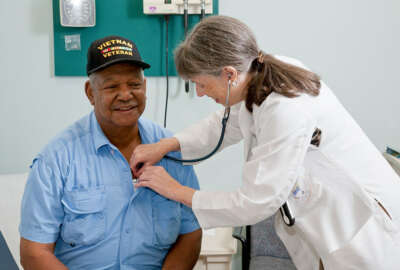VA still lacks a clear picture of its workforce needs, auditors say
The Department of Veterans Affairs anticipates it will develop an enterprise wide staffing model for direct patient care positions by 2022, with the goal of...
The Department of Veterans Affairs doesn’t have a clear sense of how many people it needs to accomplish certain tasks, particularly those with direct patient care roles, the agency’s inspector general said.
A VA-wide staffing model — one that tracks mission needs by facility and then determines the manpower requirements necessary to meet those demands — is still in the works, and the efforts to develop a cohesive one have been disjointed and often mired in confusion, the VA IG said in a recent report.
Without clear staffing models, VA and the Veterans Health Administration don’t have consistent ways of determining how many employees they need, auditors said. VA is the second-largest federal agency.
The department plans to develop initial staffing models for all direct-care positions by fiscal 2022, with the goal of validating them by 2024. VA told the IG it may develop new models more quickly, if it has more staff to work on them.
VA has long struggled to fill vacancies, particularly at VHA, which tracked 29,787 vacancies as of March of this year, according to the most recent public data available. Those numbers are an improvement over recent years, when VA consistently tracked 40,000-to-50,000 vacancies across the system.
Those numbers have actually improved in recent years, particularly as the VHA has hired more staff more quickly during the COVID-19 pandemic. As of the end of March, VA had nearly 8,000 COVID-19 employees on board, according to the latest public data. The overwhelming majority of new hires since the pandemic work for VHA.
The department has said many of its COVID-19 hires will become permanent VA employees, in part, to support a surge in demand for health care as veterans pursue treatment they postponed during the early days of the pandemic. VA’s 2022 budget request supports the conversion of those temporary hires for the pandemic to permanent employees, Secretary Denis McDonough has said.
While the number of severe staffing shortages at VHA has decreased since 2018, at least two-thirds of the department’s medical facilities say that they have fewer staff than needed to meet operational demands in five clinical and five non-clinical positions, the IG said.
A lack of qualified applicants, turnover, noncompetitive salaries and other recruitment challenges are all reasons for the staffing shortages at VHA, facility leaders told the IG.
The department has developed and validated one staffing model for caregiver support staff. Others are developed but not validated, the IG said.
But individual Veterans Integrated Service Networks (VISNs) have their own methods for defining staffing needs and workload projections.
“Nearly half of the facilities were using local methods to determine their staffing level requirements,” auditors said. “This suggests there was a lack of consistency in how requirements were determined across VHA. Without some level of consistency across VHA in how requirements are determined, collected facility-level requirements cannot be aggregated in a reliable way to inform budget or workload.”
It doesn’t help that VA and VHA have different definitions of what a staffing model is, the IG said, and leaders at local facilities had varying knowledge and opinions of staffing models that already exist but haven’t been validated formally at the top levels of the department.
“Staffing models that produce a minimum level of staff required to meet demand were described as helpful,” the IG said. “However, VISN directors were concerned that a model determining a minimum level of staff would be used as a mandatory metric. VISN directors explained that budgetary restraints, or the inability to hire certain occupations due to a lack of qualified applicants, especially in more rural areas, often made mandatory staffing levels unachievable in certain occupations.”
The department doesn’t use any staffing models that do exist to inform its annual budget requests, auditors said. Instead, VA uses enrollee health care projections to inform and propose staffing levels in the annual budget, but the methodology has its flaws.
“Facility directors are allocated funds at the beginning of each year and must determine staffing needs to fit within that allocation,” the IG said. “VISN directors reported that facilities must make trade-offs in how they address such gaps based on available budget. Facilities are balancing efficiencies by taking positions away from one service with less demand to authorize new positions in a service with higher demand. This can create difficulties when position funds are authorized through different appropriations, such as clinical positions and administrative positions.”
In addition, the VA and VHA offices charged with developing staffing models are understaffed themselves, putting the department’s goals at risk.
The VA Manpower Office, for example, has 12 employees responsible for developing staffing models, validating them and providing other support. But these employees often receive additional responsibilities unrelated to the staffing model work, auditors said.
The IG urged VA to prioritize staffing model development, and the department agreed.
Copyright © 2025 Federal News Network. All rights reserved. This website is not intended for users located within the European Economic Area.
Nicole Ogrysko is a reporter for Federal News Network focusing on the federal workforce and federal pay and benefits.
Follow @nogryskoWFED






